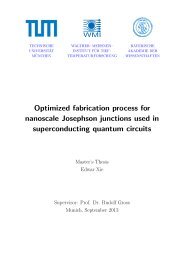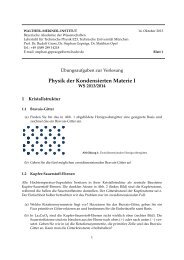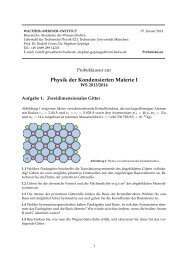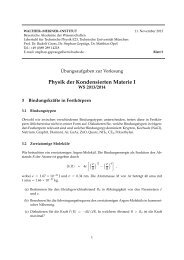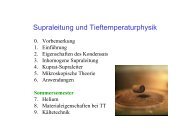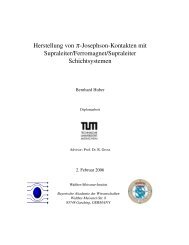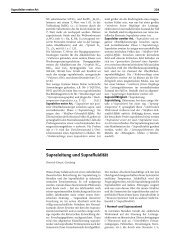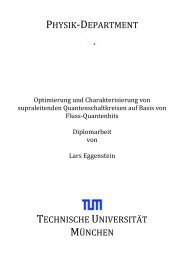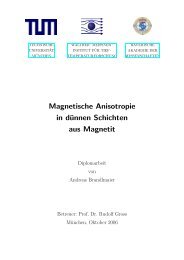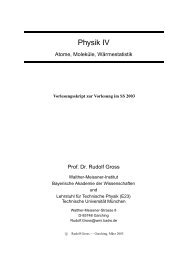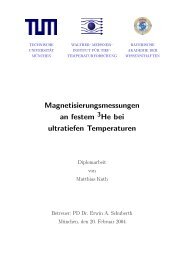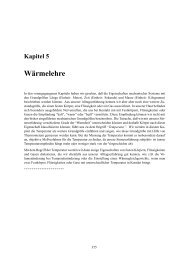Surface magneto-plasmons in magnetic multilayers - Walther ...
Surface magneto-plasmons in magnetic multilayers - Walther ...
Surface magneto-plasmons in magnetic multilayers - Walther ...
You also want an ePaper? Increase the reach of your titles
YUMPU automatically turns print PDFs into web optimized ePapers that Google loves.
Section 2.2<br />
Dispersion relation 11<br />
Further, it is noted that surface <strong>plasmons</strong> can only be excited by p-polarised light<br />
(electric field vector parallel to the <strong>in</strong>cident plane). This is obvious s<strong>in</strong>ce surface<br />
<strong>plasmons</strong> are longitud<strong>in</strong>al oscillations and therefore only an electric field which has a<br />
parallel component to the propagation direction, can excite those oscillations.<br />
ω [s -1 ]<br />
4x10 16<br />
3x10 16<br />
1x10 16<br />
2x10 16<br />
ω<br />
p<br />
ω<br />
sp<br />
0<br />
4x10 16<br />
3x10 16<br />
2x10 16<br />
1x10 16<br />
k<br />
(a)<br />
(c)<br />
k<br />
εprism θ<br />
εAu εdielectric kc/s<strong>in</strong>θ√ε prism<br />
0 5x10 7<br />
0<br />
Au-Air<br />
Au-Air<br />
c s<strong>in</strong>(θ)<br />
( )<br />
/ √ε 0<br />
( )<br />
c/√ε 0<br />
1x10 8<br />
(b)<br />
(d)<br />
k<br />
k<br />
k<br />
0 5x10 7<br />
k x [m -1 ]<br />
εAu εdielectric θ<br />
ε θ<br />
prism<br />
εAu εdielectric kc/s<strong>in</strong>θ√ε prism<br />
Au-Air<br />
/<br />
Au-Air<br />
c s<strong>in</strong>(θ)<br />
c s<strong>in</strong>(θ)<br />
c<br />
( )<br />
/ √ε 0<br />
( )<br />
c/√ε 0<br />
Au-Glass<br />
1x10 8<br />
4x10 16<br />
3x10 16<br />
2x10 16<br />
1x10 16<br />
0<br />
4x10 16<br />
3x10 16<br />
2x10 16<br />
1x10 16<br />
Figure 2.2: Dispersion relation of surface <strong>plasmons</strong>. The black l<strong>in</strong>e ( )is the dispersion<br />
relation for a gold-air <strong>in</strong>terface. The red l<strong>in</strong>e ( ) is the dispersion relation for<br />
light with k-vector parallel to the <strong>in</strong>terface. The dotted red l<strong>in</strong>e ( ) is the<br />
dispersion relation for light under the <strong>in</strong>cident angle θ. The blue l<strong>in</strong>es are the<br />
dispersion relations for light coupled through a prism, parallel to the <strong>in</strong>terface<br />
( ) and under the <strong>in</strong>cident angle θ ( ). And the magenta l<strong>in</strong>e ( ) is the<br />
dispersion relation for a glas-gold <strong>in</strong>terface. The <strong>in</strong>set <strong>in</strong> the upper left shows<br />
the Kretschmann configuration with the k vectors for the <strong>in</strong>cident light and<br />
the surface <strong>plasmons</strong>.<br />
2.2.1 Kretschmann-Raether configuration<br />
As mentioned above it is possible to excite surface <strong>plasmons</strong> when the light is coupled<br />
<strong>in</strong>to a prism before it is reflected at the metal <strong>in</strong>terface.<br />
This method was first <strong>in</strong>troduced by Erw<strong>in</strong> Kretschmann and He<strong>in</strong>z Raether <strong>in</strong> 1968<br />
0



